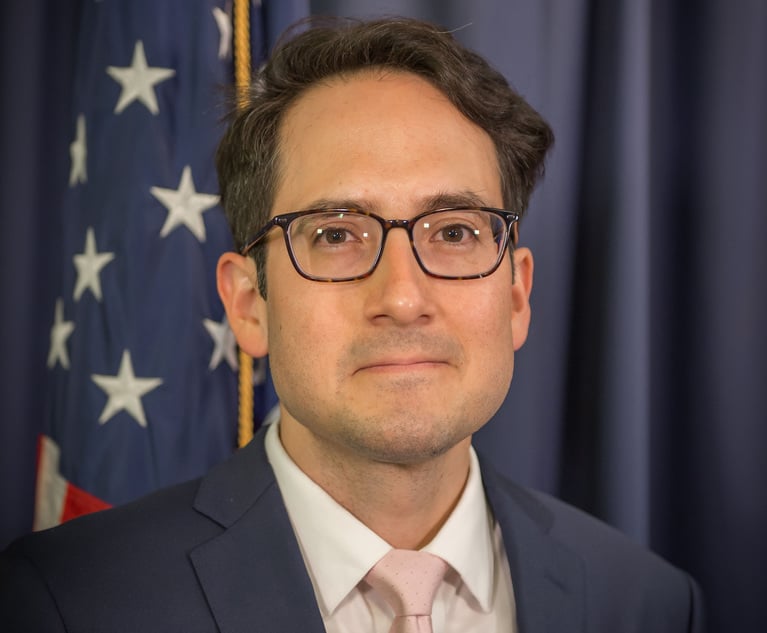Regulatory: Considering energy regulations—Coal
A recent EPA decision will have an important impact on the future use of our baseline fuel.
January 04, 2012 at 06:19 AM
4 minute read
The original version of this story was published on Law.com
Consideration of energy regulation must begin with coal—the baseline fuel for the American economy.
Coal accounts for 45 percent of the electricity generated in the U.S., and coal-fired plants are the nation's single largest source of air pollution. While local opposition to siting new plants is a perennial concern, the major controversies over coal as an energy source involve air pollution regulations intended to reduce the adverse health effects of toxic chemicals in smokestack emissions and, increasingly, to limit carbon dioxide emissions. Disputes over air pollution rules for coal-fired electricity plants have dominated the battles between Congress and the Obama Administration over regulatory policy.
On Dec. 21, the Environmental Protection Agency (EPA) issued the most expensive air pollution regulation in its history—the Utility Maximum Achievable Control Technology Rule, which took two decades to develop. This rule will require coal-fired plants to make major reductions in mercury, acid gases and sulfur dioxide emissions within four years.
Combined with the Cross-State Air Pollution Rule (CSPAR) that the EPA issued in July 2011, the rule will require major modifications in the country's electricity generation infrastructure. It marks the final reversal of a policy decision Congress made in 1976, in the aftermath of the first Arab oil embargo, that older and dirtier coal plants would not be compelled to close, but could continue to operate as the economy ratcheted down its use of oil.
The Utility MACT rule is designed as an action-forcing device that will induce owners to close many older coal plants that lack modern pollution controls because the cost of retrofitting those plants, especially smaller facilities, will exceed the costs of obtaining replacement power from natural gas-fired plants. Cost comparisons by Clear View Energy Partners suggest that 17.4 gigawatts of coal-fired capacity will be retired as a result of the rule. The economic consequences of the rule are quite significant, as are the projected health benefits. The EPA estimates that the rule will cost power companies $9.6 billion per year and increase electricity rates by 3.1 percent.
The Utility MACT rule is a seminal act in EPA's efforts to reduce air pollution from electric plants. The technology required to accomplish the reductions in emissions of the toxic gas emissions covered by this rule also will substantially reduce emissions of other pollutants regulated under existing rules (e.g., sulfur dioxide), so that there will be less pollution for EPA to eliminate when it considers rule revisions. The next generation of power plant rules are likely to focus more directly on reduction in Greenhouse Gas emissions as well as on adverse health effects.
The EPA's calculation of the benefits and costs of the Utility MACT rule are highly controversial, and the rule will be challenged in court. Further, the electric utility industry has substantial concerns that the rule will undermine the reliability of the country's electricity distribution network. The short, four-year transition period provided by the EPA may not afford utilities enough time to plan, obtain necessary licenses and permits, and construct a gas-fired plant to replace a coal plant that must clean up or die by December 2015.
The Utility MACT rule illustrates how U.S. energy policy is made. Policy is not determined directly and comprehensively. It emerges as a by-product of decentralized efforts to solve other problems. The EPA is a specialized agency dedicated to fighting pollution, and has neither the authority, the expertise, nor the resources to determine the optimum mix of fuels for the country. Yet the EPA's decision will have an important impact on the future use of our baseline fuel, and thereby trigger relative price changes and substitution of other fuels for coal throughout the economy.
The next column will analyze regulation of the principal fuel used for transportation—oil.
This content has been archived. It is available through our partners, LexisNexis® and Bloomberg Law.
To view this content, please continue to their sites.
Not a Lexis Subscriber?
Subscribe Now
Not a Bloomberg Law Subscriber?
Subscribe Now
NOT FOR REPRINT
© 2025 ALM Global, LLC, All Rights Reserved. Request academic re-use from www.copyright.com. All other uses, submit a request to [email protected]. For more information visit Asset & Logo Licensing.
You Might Like
View All
Fired NLRB Member Seeks Reinstatement, Challenges President's Removal Power

GOP-Led SEC Tightens Control Over Enforcement Investigations, Lawyers Say

GOP Now Holds FTC Gavel, but Dems Signal They'll Be a Rowdy Minority
6 minute read
Trump's Inspectors General Purge Could Make Policy Changes Easier, Observers Say
Trending Stories
- 1DC Circuit Keeps Docs in Judge Newman's Misconduct Proceedings Sealed
- 2Litigators of the Week: US Soccer and MLS Fend Off Claims They Conspired to Scuttle Rival League’s Prospect
- 3Litigator of the Week Runners-Up and Shout-Outs
- 4U.S.- China Trade War: Lawyers and Clients Left 'Relying on the Governments to Sort This Out'
- 5Willkie Adds Five-Lawyer Team From Quinn Emanuel in Germany
Who Got The Work
J. Brugh Lower of Gibbons has entered an appearance for industrial equipment supplier Devco Corporation in a pending trademark infringement lawsuit. The suit, accusing the defendant of selling knock-off Graco products, was filed Dec. 18 in New Jersey District Court by Rivkin Radler on behalf of Graco Inc. and Graco Minnesota. The case, assigned to U.S. District Judge Zahid N. Quraishi, is 3:24-cv-11294, Graco Inc. et al v. Devco Corporation.
Who Got The Work
Rebecca Maller-Stein and Kent A. Yalowitz of Arnold & Porter Kaye Scholer have entered their appearances for Hanaco Venture Capital and its executives, Lior Prosor and David Frankel, in a pending securities lawsuit. The action, filed on Dec. 24 in New York Southern District Court by Zell, Aron & Co. on behalf of Goldeneye Advisors, accuses the defendants of negligently and fraudulently managing the plaintiff's $1 million investment. The case, assigned to U.S. District Judge Vernon S. Broderick, is 1:24-cv-09918, Goldeneye Advisors, LLC v. Hanaco Venture Capital, Ltd. et al.
Who Got The Work
Attorneys from A&O Shearman has stepped in as defense counsel for Toronto-Dominion Bank and other defendants in a pending securities class action. The suit, filed Dec. 11 in New York Southern District Court by Bleichmar Fonti & Auld, accuses the defendants of concealing the bank's 'pervasive' deficiencies in regards to its compliance with the Bank Secrecy Act and the quality of its anti-money laundering controls. The case, assigned to U.S. District Judge Arun Subramanian, is 1:24-cv-09445, Gonzalez v. The Toronto-Dominion Bank et al.
Who Got The Work
Crown Castle International, a Pennsylvania company providing shared communications infrastructure, has turned to Luke D. Wolf of Gordon Rees Scully Mansukhani to fend off a pending breach-of-contract lawsuit. The court action, filed Nov. 25 in Michigan Eastern District Court by Hooper Hathaway PC on behalf of The Town Residences LLC, accuses Crown Castle of failing to transfer approximately $30,000 in utility payments from T-Mobile in breach of a roof-top lease and assignment agreement. The case, assigned to U.S. District Judge Susan K. Declercq, is 2:24-cv-13131, The Town Residences LLC v. T-Mobile US, Inc. et al.
Who Got The Work
Wilfred P. Coronato and Daniel M. Schwartz of McCarter & English have stepped in as defense counsel to Electrolux Home Products Inc. in a pending product liability lawsuit. The court action, filed Nov. 26 in New York Eastern District Court by Poulos Lopiccolo PC and Nagel Rice LLP on behalf of David Stern, alleges that the defendant's refrigerators’ drawers and shelving repeatedly break and fall apart within months after purchase. The case, assigned to U.S. District Judge Joan M. Azrack, is 2:24-cv-08204, Stern v. Electrolux Home Products, Inc.
Featured Firms
Law Offices of Gary Martin Hays & Associates, P.C.
(470) 294-1674
Law Offices of Mark E. Salomone
(857) 444-6468
Smith & Hassler
(713) 739-1250






